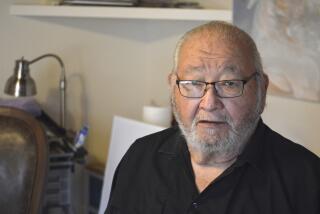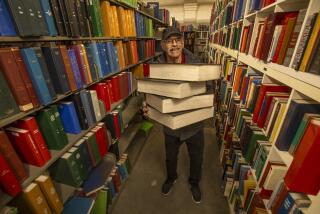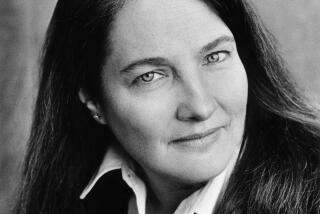Hemingway’s hideout: bring your own mood : Here there are no tourist gimmicks, no souvenirs of the author. Just his room, his memory and his grave.
- Share via
SUN VALLEY, Ida. — The room is No. 206, Hemingway’s room.
The wallpaper has been changed. So have the furniture, the plumbing, the lights, the lock--everything changed and modernized many times.
Everything but the mystique.
About twice a month on the average, year in and year out, devotees of the enduring writer and epic character are drawn to Sun Valley Lodge to book his old room and undertake a subtle, personal and sometimes moving journey of rediscovery of a man whose memory lives on here and in nearby Ketchum.
On the patio of 206, in the autumn of 1939, Ernest Hemingway wrote parts of his lusty politics-and-war novel “For Whom the Bell Tolls.” In Chapter 13 he mentions this part of Idaho as a place to settle down, which it was for him until his suicide in Ketchum in 1961.
Few places--perhaps only Key West, Fla., Havana and Paris--are as important as this in Hemingway legend. And of all places significant to his life, only this one does not cram it down a visitor’s throat.
Unlike the towns in Spain where Hemingway plaques are everywhere, or Key West’s mini-industry of Hemingway, Sun Valley and Ketchum have no postcards, no narrated cassette tours and, mercifully, no Hemingway-ate-his-last-meal-here markers. Family members still live here and value their privacy. Old pals walk the streets with memories sharp and private.
“Sun Valley still looks at itself as his friend,” said Shannon Besoyan, the lodge’s public relations director.
So coming to Idaho to reflect on Hemingway requires discretion and some industry. The rewards, however, are correspondingly intimate.
Writer, producer and former CBS news president Van Gordon Sauter, who, along with many other Americans, felt his life touched by Hemingway’s audacious interpretation of manhood, recalled finding himself in Room 206 by chance. He was reading the single brochure now in print about Hemingway in Idaho and realized that this was the room.
Drinking in public at the Paris cafes of Hemingway fame is one thing, but ending up in command of Hemingway’s parlor room was quite another. Sauter hurried out to get an anthology.
“Eerie,” he said. “ . . . It was the best Hemingway I’ve ever experienced. It was almost like he was there, personally telling me the stories.”
By timing if not by talent and personality alone, Ernest Hemingway has come to represent a passage in America from the age of writers and characters to the age of celebrities and cameras. There’s plenty of him along the way to hate, to idolize, or both.
“He was loud and he smelled. He smelled of garlic and booze,” said the woman. She is drinking at the Duchin Lounge, one of Hemingway’s old haunts. She grew up while he was here and is happy to besmirch the legend. “But don’t use my name,” she said. “I’ve got to make a living here.”
A few drinks later she is moved to tears as she recites from memory his words on the Hemingway Memorial, a small granite marker in a lonely grove outside town:
“Best of all he loved the fall/The leaves yellow on the cottonwoods/Leaves floating on the trout streams/And above the hills the high blue windless skies/Now he will be a part of them forever.”
Oral histories of local residents, on file at the Ketchum Library, are profuse with lore: How Hemingway called Room 206 “Glamor House” because of its famous guests, how his first meal in town was a plate of marinated herring and two steins of beer--and that was breakfast.
Not all of the memories are innocent.
Even within the Hemingway family there is ambivalence about Sun Valley. Son Jack and his family have lived here for years, pillars of the community. Son Patrick stays away. It’s a painful memory because Patrick’s mother was left behind when Hemingway first came to Idaho with a girlfriend who was to be his next wife.
Just this summer, for the first time since it was published in 1940, could Patrick Hemingway bring himself to reread “For Whom the Bell Tolls.”
“I liked it very much,” Patrick allowed. “It’s a very political book. . . . I get tired of Hemingway cast only as the macho writer because he was, among other things, a very good political thinker.”
Hemingway strove for immortality through literature, and now has lasted more than a generation past his death. His “alchemy,” as he called it, remains extravagant enough for son and stranger alike to rediscover, ponder, debate; and extravagant enough to lure people here looking for a memory of it.
One morning this month, a visitor stood at the gate of the Ketchum cemetery, the last stop in a Sun Valley journey.
Someone else had been there a few days earlier. A set of footprints was outlined in the crusty snow. The footprints followed a roadway out to the plain marker of Ernest Miller Hemingway. The prints showed that someone had stood there alone, shuffled a little, turned to leave and then stopped once more to look back.
More to Read
Sign up for The Wild
We’ll help you find the best places to hike, bike and run, as well as the perfect silent spots for meditation and yoga.
You may occasionally receive promotional content from the Los Angeles Times.






